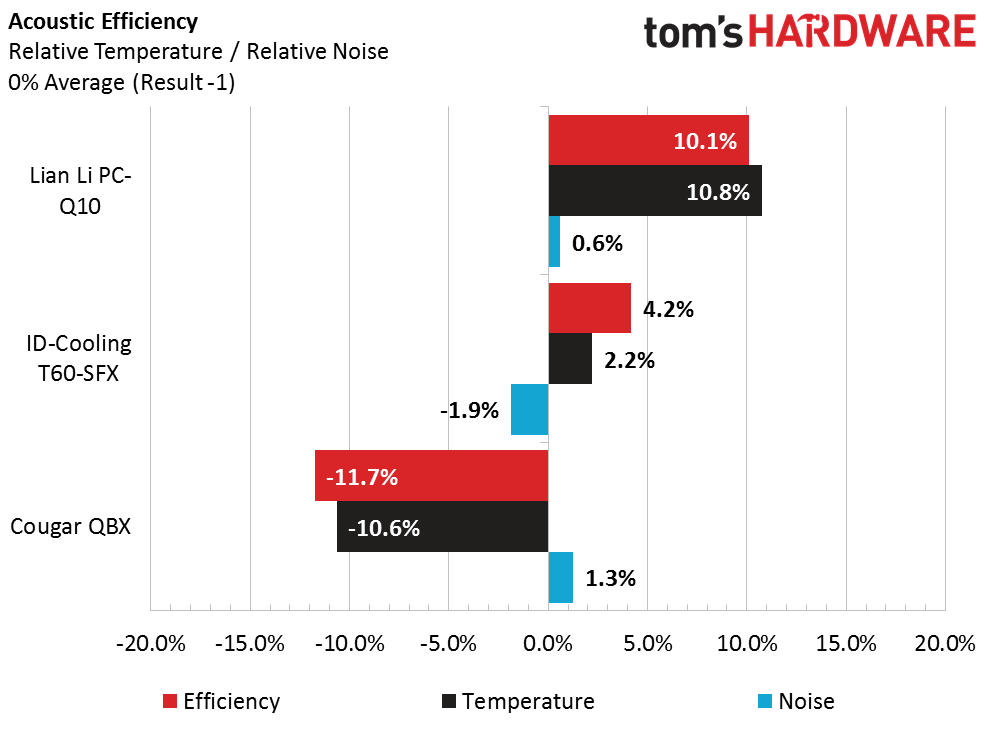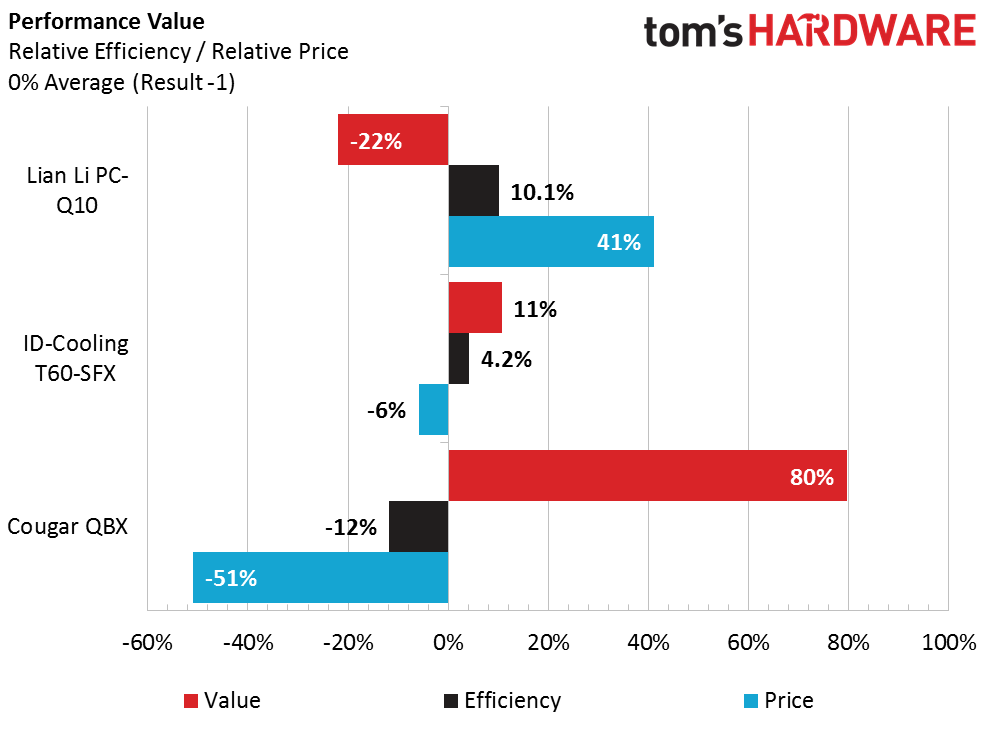Compact Mini-ITX Case Round-Up
Today we're putting three compact Mini-ITX cases to the test: Cougar's QBX, ID-Cooling's T60-SFX and Lian Li's PC-Q10.
How We Test, Results & Conclusion
Why you can trust Tom's Hardware
We've put together a brand-new reference system for 2015. All of the great hardware below comes courtesy of our awesome vendors.
Test System Components
Since we'll be dealing with small cases, often with limited airflow, we opted to not overclock the CPU in order to avoid running into thermal issues.
Noctua's NH-L12 is a great low-profile cooler, which should not only handle our Core i5-4690 with ease, but also fit into almost any case we can get our hands on.
Likewise, Gigabyte's GV-N970IXOC-4GD will not only fit in almost any chassis, but it also runs very cool (albeit by dumping its heat back in to the case).
The power comes from be quiet!'s 400W SFX Power 2, which is not yet available in the United States. Additionally, we purchased an SFX to PS/2 adapter plate so the power supply will fit in a wider range of cases, including the Cougar QBX and the Lian Li PC-Q10.
Drivers & Settings
| Chipset | Intel INF 10.0.27 |
|---|---|
| CPU | 3.90 GHz (39x 100 MHz) at 1.20 V Core |
| Motherboard | Firmware 4.8 (06/01/2015) |
| RAM | XMP CAS 9 defaults (1.35V) |
| Graphics | Maximum Fan for Thermal Tests | Nvidia GeForce 353.30 |
Benchmark Suite
Although we chose not to overclock either the CPU or GPU, our test platform should still produce plenty of heat and noise for the cases we'll be testing today.
| Benchmark Configuration | |
|---|---|
| Prime95 v27.9 | 64-bit executable, Small FFTs, 4 threads |
| 3DMark 11 | Version: 1.0.3.0, Extreme Preset: Graphics Test 1, Looped |
| Real Temp 3.40 | Average of maximum core readings at full CPU load |
| Galaxy CM-140 SPL Meter | Tested at 1/2 m, corrected to 1 m (-6 dB), dBA weighting |
Noise is measured 0.5m from the case's front corner, on the side that opens. The numbers are corrected to the 1m industry standard by subtracting 6 decibels, which is used by many loudspeaker and fan manufacturers.
Test Results
Now for the moment everyone has been waiting for, here's how each of the cases performed when we put them to the test. Additionally, since this is the first time we've used this testing platform for case testing, we decided to include test results on how the platform performed without a case, to give readers a better understanding of how each case performs. Note that the GPU fan was set to full speed in each of the full-load tests. Finally, the ambient air temperature in the room was maintained at 26 degrees Celsius (78.8 degrees Fahrenheit).
Despite being covered in mesh and designed to run cool, the QBX runs significantly warmer than the other cases in the lineup. The main issue we observed is a lack of airflow, which can be attributed to several things. First, all of the major heat-generating components, including the power supply and CPU cooler, dump their waste heat back into the case. Technically, the heat from the PSU is supposed to be jettisoned out of the top of the case, but judging from the warm spot toward the front, it appears that a good part of that air remains in the case as well. Second, the case just has a single 92mm cooling fan, which is only going to do so much, especially when it's packed full of equipment. Finally, all of that mesh that looks like it should help keep things cool is actually part of the problem. There's nothing inside to case to help control the flow of air, so while a good amount of air will move through the case, the lack of direction to the parts that actually need cooling contributes to the formation of hot spots. We're guessing that if this case had an extra fan or two, we would see this issue disappear pretty quickly.
Interestingly enough, despite having only a single case fan and not much else in the cooling department, the T60-SFX runs significantly cooler than the Cougar QBX when it comes to the GPU temperature. This is probably due to the location of the case's air intakes that serve more or less as a funnel, running all of the ambient air past the graphics card before it's brought up to the CPU. Overall, even the CPU runs a few degrees cooler in this case, which is somewhat surprising given its design.
Last up, the Lian Li PC-Q10 delivers some interesting results of its own. It's the coolest running case of the roundup and even comes close to the performance of our open test bench. The performance of the PC-Q10 can be attributed its 120mm exhaust fan which moves a significant amount of air, as well as a design that favors a strong front-to-back and bottom-to-top airflow through the use of carefully placed vents.
Surprisingly enough, all three of the cases in the lineup perform about the same when it comes to containing the jet engine like whine that emanates from Gigabyte's GTX 970. More so, all three of the cases do an equally mediocre job at keeping things quiet.
Unsurprisingly, in addition to running warm, the QBX also runs quite loud as all of that mesh on the side panels does very little to dampen the noise. The T60-SFX manages to perform slightly better than the QBX in the noise department, but also fails to make any significant impact in the noise over the other two cases. Finally, the PC-Q10 also produces somewhat disappointing results, failing to do much to contain the noise.
Just a quick note before we move on: we removed the open air test platform from the efficiency and value charts in order to avoid having our results skewed by the unfair advantage that platform has over the cases.
The PC-Q10 from Lian Li wins hands down in the efficiency department, mainly due to its ability to keep its internals cool, despite the fact that it isn't all that quiet. Next up is the T60-SFX from ID Cooling, which takes second place due to its ability to keep the GPU running at a much cooler temperature than the QBX, while also running ever so slightly quieter. Finally, we have the QBX from Cougar, which takes a big hit in the efficiency department due to its inability to keep temperatures down with only a 92mm exhaust fan.
When it comes time to compare the actual cost to efficiency value of the cases, we see a much different picture. The Cougar QBX takes a commanding lead when it comes to value due to its mere $55 price tag. So, even if the QBX isn't actually very efficient, its budget-friendly price tag more than makes up for its shortcomings. The T60-SFX manages to come home with second place in our value comparison, thanks to a combination of its performance and price. Finally, although it’s the most efficient case in our roundup, the PC-Q10's price haunts it in the end. Coming in at an MSRP of $120, the PC-Q10's premium price tag isn't exactly budget friendly and is reflected as such in our comparison.
Conclusion
Cougar QBX
Reasons to buy
Reasons to avoid
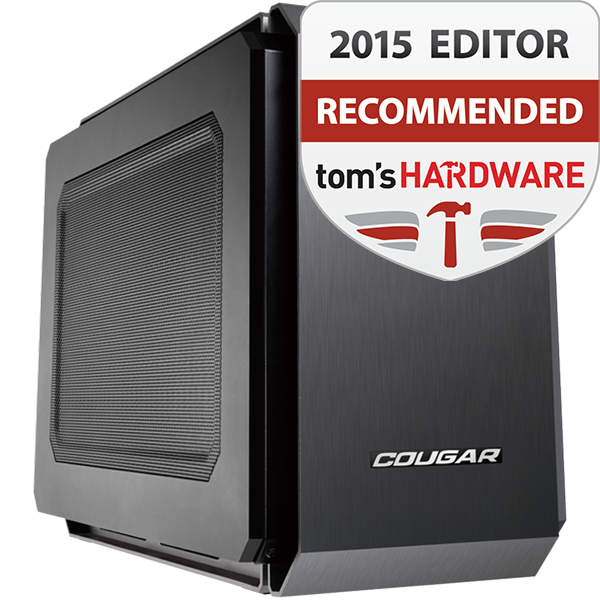
ID-Cooling T60-SFX
Reasons to buy
Reasons to avoid
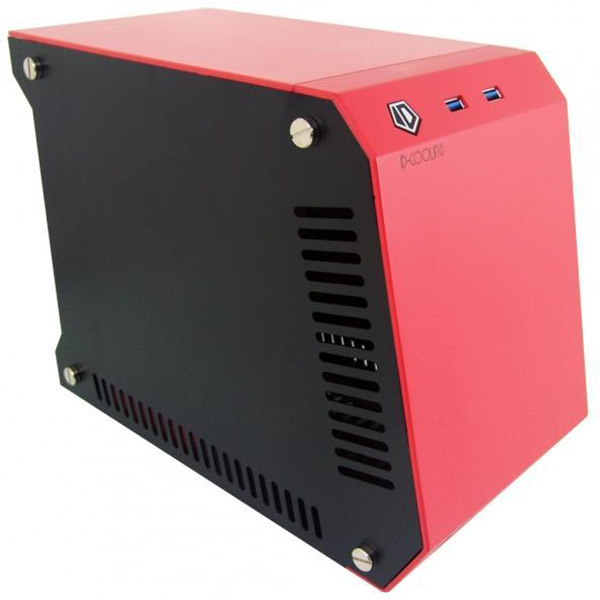
Lian Li PC-Q10
Reasons to buy
Reasons to avoid
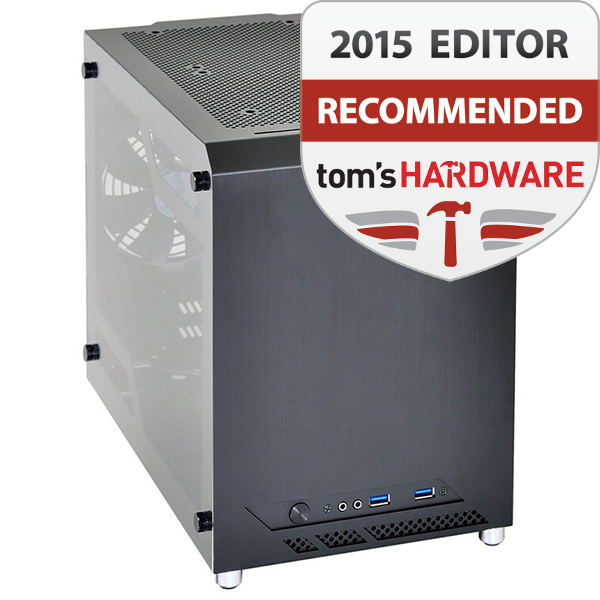
MORE: All Case ContentMORE: How To Build A PC
Chris Miconi is an Associate Contributing Writer for Tom's Hardware, covering Cases.
Follow us on Facebook, Google+, RSS, Twitter and YouTube.
Get Tom's Hardware's best news and in-depth reviews, straight to your inbox.
-
Onus Honestly I cannot say I liked this one. Yes, it provides good information on three specific cases, but is missing too much information to be useful as a "Round-Up." I would like to have seen a few more case styles tested, such as one of the InWin BP655 series, a Prodigy or Neutron, and one of the small cheap "breadbox" cases.Reply
Also, I know time is limited, but another fifteen minutes to install an additional fan in the QBX and test the author's otherwise reasonable supposition would have significantly increased the value of the information provided about that case. -
jtd871 If the 970 card that you used is that loud and/or annoying, I wonder why you didn't select a larger (although still within standard PCIe dimensions) dual-fan card, instead. Additionally, these cases are relatively large compared to the volume of the components, which is going to make airflow really challenging. The beauty of *really* small cases is that there is less extra volume for hot air to accumulate inside the case (but there needs to be lots of available ventilation for each of the components).Reply
I didn't read the write-up on the individual cases, but did you try setting the PSU as an exhaust to improve airflow? -
JasonL265 Was this an older article that was just publish today. They kept on complaining about Lian Li's more expensive price tag and even listed it as a con for the case. But the ID case is like $30 bucks more, and instead they say the ID case has a "decent" priceReply -
jjb8675309 Would have been nice to see more budget oriented cases geared towards bottom dollar (apu) mini-itx builds.Reply -
cmiconi ReplyWas this an older article that was just publish today. They kept on complaining about Lian Li's more expensive price tag and even listed it as a con for the case. But the ID case is like $30 bucks more, and instead they say the ID case has a "decent" price
The ID-Cooling case was selling for just above its MSRP of $79.99 back when the article was written. Since then the price has doubled on Newegg for some reason. Additionally, the charts in the article were made with the case's MSRP and not its current selling price. -
cmiconi I also wanted to clarify some of the questions.Reply
The case selection of the round-up was intended to compare cases of a similar size. When we put out our call for cases, we got almost a dozen cases in two weeks, in all sorts of different designs (and more are still on their way). One thing we didn't get a lot of was budget cases. Once we get through reviewing most of the cases that came in, we might put together another round-up of 3-5 budget mini-ITX cases.
The mini GTX 970 was chosen so that we didn't have to worry about the graphics card not fitting into any of the cases that we received. We did get some cases in which a regular size card won't fit. So, instead of testing with two different graphics cards, we can use a single card which helps to keep a consistent baseline for the test results across all of the cases. -
2Be_or_Not2Be What, no Silverstone cases? They have a good range of mini-ITX cases. The SG05 and the SG13 go for $30-45 USD on Newegg. Surely that's a nicely-priced budget case.Reply -
kyle382 I have been waiting so long for SFF case reviews from toms. Thank you! I didn't even know about the ID cooling brand until I read this.Reply -
kyle382 Reply16937276 said:What, no Silverstone cases? They have a good range of mini-ITX cases. The SG05 and the SG13 go for $30-45 USD on Newegg. Surely that's a nicely-priced budget case.
calm down there buddy...more will coming.
".. from various vendors including Corsair, Cougar, Deep Cool, ID Cooling, Lian Li and more."
-
jjb8675309 Reply16937054 said:Once we get through reviewing most of the cases that came in, we might put together another round-up of 3-5 budget mini-ITX cases.
That would be awesome. Looking for a $40-60 budget case right now.


